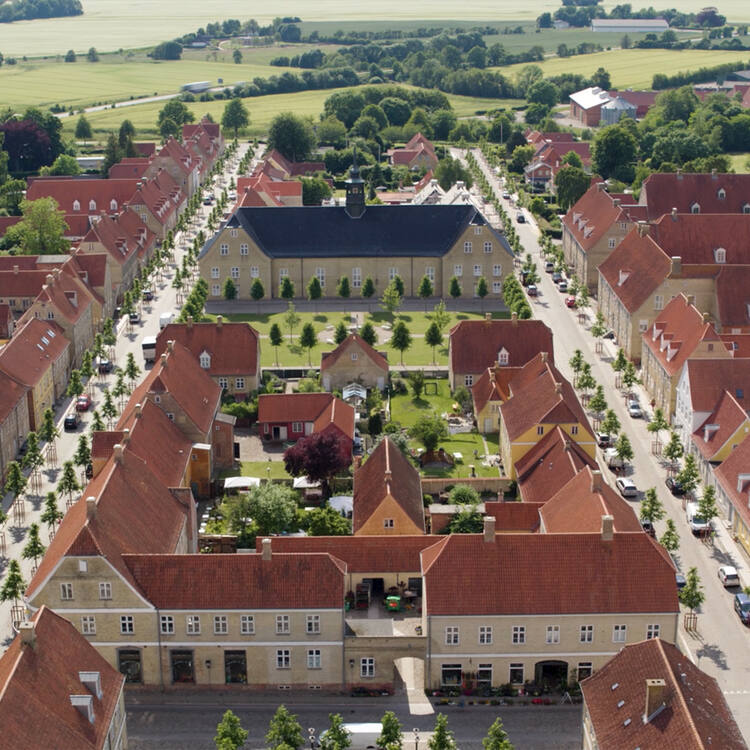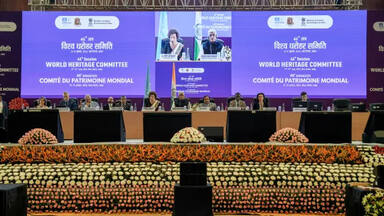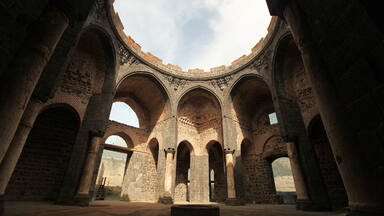Moravian Church Settlements
Moravian Church Settlements
The Moravian Church Settlements is a transnational serial extension of Christiansfeld, a Moravian Church Settlement (Denmark), already inscribed on the World Heritage List. The extension includes three municipalities founded in the 18th century: Herrnhut (Germany), Bethlehem (United States of America), and Gracehill (United Kingdom of Great Britain and Northern Ireland). Each settlement has its own architectural character based on ideals of the Moravian Church but adapted to local conditions. Together, they represent the transnational scope and consistency of the international Moravian community as a global network. There is an active congregation present in each component part, where traditions are continued and constitute a living Moravian heritage.
Description is available under license CC-BY-SA IGO 3.0
Colonies de l’Église morave
Les Colonies de l’Église morave sont une extension transnationale en série de Christiansfeld, une colonie de l’Église morave (Danemark), déjà inscrit sur la Liste du patrimoine mondial. L’extension comprend trois municipalités fondées au XVIIIe siècle : Herrnhut (Allemagne), Bethléem (États-Unis d’Amérique) et Gracehill (Royaume-Uni de Grande-Bretagne et d’Irlande du Nord). Chaque colonie a son propre caractère architectural, basé sur les idéaux de l’Église morave, mais adapté aux conditions locales. Ces bâtiments représentent ensemble la dimension et la cohérence transnationales de la communauté morave internationale en tant que réseau mondial. De nos jours, une congrégation est active dans chaque élément constitutif, où des traditions sont perpétuées et constituent un héritage morave vivant.
Description is available under license CC-BY-SA IGO 3.0
مستعمرات الكنيسة المورافية
تُعتبر مستعمرات الكنيسة المورافية امتداداً متسلسلاً عابراً للحدود لموقع "كريشتشانزفلد، مستعمرة تابعة للكنيسة المورافية" (الدنمارك)، المُدرج بالفعل في قائمة التراث العالمي. ويشمل الامتداد ثلاث بلديات أنشئت في القرن الثامن عشر، هي: بلدية هرنهوت (ألمانيا)، وبلدية بيت لحم (الولايات المتحدة الأمريكية)، وبلدية غرايسيهيل (المملكة المتحدة لبريطانيا العظمى وأيرلندا الشمالية). وتكتسي كل مستعمرة طابعاً معمارياً خاصاً قوامه مُثُل الكنيسة المورافية التي أُدخلت عليها بعض التعديلات للتكيف مع الظروف المحلية. وتجسد هذه البلديات مجتمعةً نطاق المجتمع المورافي الدولي واتساقه العابرين للحدود الوطنية باعتباره شبكة عالمية. وثمّة طائفة فاعلة في كل جزء من الأجزاء المكونة للموقع، والتي تحافظ على التقاليد وتمثل تراثاً مورافياً حياً.
source: UNESCO/CPE
Description is available under license CC-BY-SA IGO 3.0
摩拉维亚居留区
摩拉维亚居留区是已列入《世界遗产名录》丹麦遗产“克里斯丁菲尔德,摩拉维亚居留区”的跨国系列扩展。此次扩展包括3座建于18世纪的城镇:德国的黑恩胡特、美国的伯利恒和英国的格雷斯希尔,每个居留区的建筑都在摩拉维亚教会理想风格的基础上结合当地条件而自成特色。它们共同代表了摩拉维亚国际社区这一全球网络超越国界、和谐一致的特性。居留区的每个组成部分都有一个活跃教会,会众让传统得以延续,并构成摩拉维亚活态遗产。
source: UNESCO/CPE
Description is available under license CC-BY-SA IGO 3.0
Поселения Моравской церкви
Поселения Моравской церкви — это транснациональное расширение серийного объекта Кристиансфельд, поселения Моравской церкви в Дании, уже включенного в Список всемирного наследия. Расширенный объект включает в себя три муниципалитета, основанных в XVIII веке: Хернхут (Германия), Бетлехем (Соединенные Штаты Америки) и Грейсхилл (Соединенное Королевство Великобритании и Северной Ирландии). Каждое поселение имеет свои архитектурные особенности, основанные на идеях Моравской церкви, но в то же время отражающие местную специфику. Все они образуют единую международную сеть общины Моравской церкви. В каждом из них проживает активная паства, продолжающая традиции Моравской церкви и ставшая живым наследием.
source: UNESCO/CPE
Description is available under license CC-BY-SA IGO 3.0
Colonias de la iglesia morava
Las Colonias de la iglesia morava es una extensión transnacional en serie de Christiansfeld, una colonia de la iglesia morava (Dinamarca), sitio que ya estaba inscrito en la Lista del Patrimonio Mundial. La extensión comprende tres municipios fundados en el siglo XVIII: Herrnhut (Alemania), Bethlehem (Estados Unidos de América) y Gracehill (Reino Unido de Gran Bretaña e Irlanda del Norte). Cada colonia presenta su propio carácter arquitectónico, basado en los ideales de la iglesia morava, pero adaptado a las condiciones locales. Juntas, las colonias representan el alcance transnacional y la coherencia de la comunidad morava internacional como red mundial. En cada parte del sitio existe una congregación activa donde las tradiciones se perpetúan y constituyen un patrimonio vivo moravo.
source: UNESCO/CPE
Description is available under license CC-BY-SA IGO 3.0
Outstanding Universal Value
Brief synthesis
The Moravian Church Settlements in Herrnhut (Saxony, Germany), Bethlehem (Pennsylvania, United States of America), Gracehill (Northern Ireland, United Kingdom of Great Britain and Northern Ireland), and Christiansfeld (Jutland, Denmark) were established according to overarching planning principles that reflected the ideals of the Moravian Church, as expressed in their plans and democratic organisation. Herrnhut, founded in 1722 as the “mother settlement”, is a testimony to the original Moravian urban and architectural design principles, as well as the key attributes of the Church’s spiritual, societal, and ethical ideals. Bethlehem, established in 1741, is the first permanent, best-preserved, and most important Moravian Church settlement in North America. Gracehill, developed in 1759 and featuring a grid-like plan focused on a village square, is the best-preserved Moravian Church settlement on the islands of Great Britain and Ireland. Founded in 1773, Christiansfeld, with its intact central square and impressive collection of buildings, presents the best-preserved example of a northern European Moravian Church settlement. Each architectural ensemble bears witness to the Moravian Church’s vision of a unified, coherent urban design, inspired by the concept of an “ideal city” developed by the Church during its formative phase in the 18th and beginning of the 19th centuries.
All four settlements have distinctive Moravian buildings, including a particular type of Gemeinhaus (congregation building), church, and choir houses (large structures designed as communal dwellings for unmarried men, unmarried women, and widows), as well as a nearby God’s Acre (cemetery). Each settlement has its own architectural character based on an original Moravian Church Civic Baroque style but adapted to local conditions. Together, these settlements represent the transnational scope and consistency of the international Moravian community as a global network. Present today in each component part is an active congregation whose continuation of traditions forms a living Moravian heritage.
Criterion (iii): The transnational series of Moravian Church settlements bears exceptional testimony to Moravian Church principles, which are expressed in their layouts, architecture, and craftsmanship, as well as the fact that numerous buildings are still used for their original functions or for the continuation of Moravian Church activities and traditions. The Herrnhut, Bethlehem, Gracehill, and Christiansfeld settlements, each possessing an exceptional range of tangible and intangible attributes, represent a vibrant worldwide network in which no settlement or congregation exists in isolation. Together, they highlight the Church’s influence in colonisation processes and missionary work, and its structure as a network during its formative phase during the 18th and beginning of the 19th centuries. The continuing presence of Moravian Church communities in each of the settlements ties their historic layouts and structures to the living cultural tradition of the Moravian Church and to the larger Moravian Church community.
Criterion (iv): The transnational series of Moravian Church settlements are an outstanding example of religious town planning, within the Protestant tradition, combining both the spiritual aspects and the practical considerations of community life. Each architectural ensemble bears witness to the Moravian Church’s vision of a unified, coherent urban design, inspired by the concept of an “ideal city” and anticipating Enlightenment ideals of equality and social improvement that became a reality for many only much later. The democratic organisation of the Moravian Church is expressed in its humanistic town planning and important buildings for the common welfare, and in the visual and functional connections between individual elements and with the landscape setting. These settlements, established during the formative phase of Moravian Church settlements, stand for the movement towards democratisation, offering the same standard of living to all its members and advancing the well-being of the group. Each settlement possesses distinctive functions and illustrates unity through homogeneous groups of buildings with shared styles, materials, and proportions (each adapted to local conditions), together with a high quality of craftsmanship.
Integrity
The transnational serial property includes all the attributes necessary to convey its Outstanding Universal Value, and is of adequate size to ensure the complete representation of the features that express its significance. The property comprises four component parts that together illustrate the origins, evolution, and global spread of Moravian Church settlements during their formative phase. They represent the continuing religious heritage, each sharing a common set of attributes while contributing to the series, including through distinctive geographical and cultural reach, representative variations in urban plans, exemplars of specific building types, regional contributions in architectural style and local construction materials, temporal sequence of establishment, and linkages with other settlements and mission stations.
Urban plans remain legible and are largely intact. Visual and functional relationships within the settlements and, in some cases, with surrounding landscapes, are still largely extant and readable. None of the settlements suffer from neglect and none are threatened by irreversible change.
Authenticity
The transnational serial property is substantially authentic in terms of location and setting, form and design, materials and substances, and workmanship. Many of the buildings remain in use by the Moravian Church. The continuity of the Moravian Church community contributes to safeguarding the authentic spirit and feeling as well as atmosphere of the serial property. The presence of an active community in each settlement sustains a living Moravian Church cultural tradition.
Most of the residential units have modernised interiors to be in line with contemporary living standards whilst aiming to retain their authenticity wherever possible. In some cases, renovations could have been implemented with more respect for authenticity, and aspects of historic construction materials and techniques could have been retained. Future modernisations, including interiors, should pay special attention to the conservation of historic fabric. Conservation and maintenance programmes should be developed for the key attributes, and the use of appropriate conservation techniques and materials should be ensured.
Protection and management requirements
Each component part of the serial property benefits from protection guaranteed through legislation and spatial planning regulations anchored in the respective protective mechanisms of each State Party. Responsibility for the protection of each of the component parts of the property rests with the national, regional, and/or local authorities, as the case may be.
The Moravian Church community has for the past three centuries provided traditional protection of its buildings through the requirements of the Church for their use, and remains very active in upholding its religious and social services. Such activities also sustain the spiritual, social, and ethical principles that underpin the significance of the settlements.
An overall management system for the transnational serial property has been established, with an International Management Plan and action plan approved by all key stakeholders. An International Governmental Committee, made up of national World Heritage Focal Points and/or a representative of the highest monument or heritage protection authority, will be responsible for matters at the level of States Parties and their obligations under the World Heritage Convention, while a Transnational Coordination Group will comprise representatives of each component part. A Moravian Church Transnational Advisory Group will provide a consistent viewpoint on matters of tangible and intangible attributes. Each component part will have a Site Manager/Coordinator and a Local Management Plan that conforms to the overarching International Management Plan.



